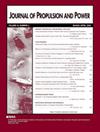液态氧/气态甲烷单元素剪切同轴火焰动力学
IF 2.4
4区 工程技术
Q2 ENGINEERING, AEROSPACE
引用次数: 0
摘要
实验研究了单元素剪切同轴液态氧(LOX)/气态甲烷火焰在高但仍为亚临界压力下的动力学和光谱,以及甲烷在超临界温度下的动力学和光谱。采用高速阴影成像技术对靠近液氧后区域的火焰和射流动力学进行成像和跟踪。高速[公式:见文]和[公式:见文]化学发光也同时沿着与阴影图相同的视线采集。将结果与之前使用相同注入器在相同动量通量比下的LOX/氢气结果进行了比较。甲烷的初始温度在200 ~ 300 K之间变化。我们发现液氧/甲烷火焰与之前研究的液氧/氢火焰有许多共同的特征,但也有显著的差异。液氧/氢气火焰的蔓延速度大于液氧/甲烷火焰。氢气的扩散速率波动幅度也较大,但经平均扩散速率归一化后的相对扩散速率波动幅度大致相同。尽管存在差异,但先前发现的对剪切同轴LOX/氢气火焰有效的波放大机制也被发现对LOX/甲烷火焰有效。总的来说,液氧/甲烷火焰和液氧/氢气火焰在光谱上都相当安静。本文章由计算机程序翻译,如有差异,请以英文原文为准。
Liquid Oxygen/Gaseous Methane Single-Element Shear Coaxial Flame Dynamics
An experimental study was conducted to visualize the dynamics and spectra of single-element shear coaxial liquid oxygen (LOX)/gaseous methane flames at high but still subcritical pressure for the LOX, and at supercritical temperature for the methane. High-speed shadowgraphs were employed to image and track the flame and jet dynamics close to the liquid oxygen’s post region. High-speed [Formula: see text] and [Formula: see text] chemiluminescence were also simultaneously collected along the same line of sight as the shadowgraphs. The results were compared to previous LOX/hydrogen results using the same injector at the same momentum flux ratios. The initial temperature of the methane was varied between 200 and 300 K. The LOX/methane flames were found to share many features in common with the LOX/hydrogen flames previously studied, but there were notable differences. The spreading rate of the LOX/hydrogen flames was larger than that of LOX/methane flames. The amplitude of the spreading rate fluctuations for hydrogen was also larger, although the relative spreading rate fluctuations normalized by the average spreading rates were about the same. Despite the differences, a wave amplification mechanism found previously to be active for shear coaxial LOX/hydrogen flames was found to also be active for LOX/methane flames. Overall, both the LOX/methane flames and the LOX/hydrogen were both found to be spectrally fairly quiet.
求助全文
通过发布文献求助,成功后即可免费获取论文全文。
去求助
来源期刊

Journal of Propulsion and Power
工程技术-工程:宇航
CiteScore
4.20
自引率
21.10%
发文量
97
审稿时长
6.5 months
期刊介绍:
This Journal is devoted to the advancement of the science and technology of aerospace propulsion and power through the dissemination of original archival papers contributing to advancements in airbreathing, electric, and advanced propulsion; solid and liquid rockets; fuels and propellants; power generation and conversion for aerospace vehicles; and the application of aerospace science and technology to terrestrial energy devices and systems. It is intended to provide readers of the Journal, with primary interests in propulsion and power, access to papers spanning the range from research through development to applications. Papers in these disciplines and the sciences of combustion, fluid mechanics, and solid mechanics as directly related to propulsion and power are solicited.
 求助内容:
求助内容: 应助结果提醒方式:
应助结果提醒方式:


